| |
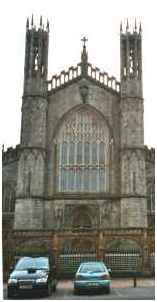
Where is
this?
You'll recognise the building it's been copied from, I've
no doubt, but where is this extraordinary church? Is it
in some anonymous suburb of London? Is it in some
mid-western state where the town planners of a century
ago had big ideas? Or is it some far-flung corner of the
former British Empire?
DUNDALK
Those of you who went for the 'British Empire' option
were closest. This is St Patrick's catholic church in
Dundalk, in the Republic of Ireland. It is a half-scale
copy of King's College Chapel, Cambridge, with a
Westminster-esque tower tagged on. Here's another shot
from a slightly different angle.
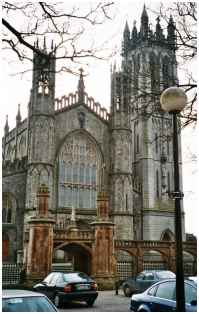
|
|
Dundalk, in County Louth,
is just south of the South Armagh border; this is
bandit country, and the town got a reputation in
the 1980s and 1990s as 'El Paso', after one of
the many IRA men on the run there, drinking in a
town centre bar, got disgruntled watching his
horse lose a race, and took out his gun and shot
the television.
Today, it is a town on the up - more than
anywhere in the republic, Dundalk bears witness
to the millions of pounds of European money
poured into it over the last few years. It's a
lively place on a Saturday night, too.
Five miles to the north of Dundalk, on the road
to Newry, is St Mary's church, Ravensdale. I went
to Mass here. The little church, greatly extended
at some point in the last 40 years, but still
retaining the former east window and altar,
nestles in mountains hard against the border.
Although Ravensdale is in the republic, the
British army's hilltop Bessbrook base is above it
on the hilltop, monitoring activities beyond Her
Majesty's jurisdiction. Incidentally, it is
supposed to have the busiest helicopter pad in
the world.
Not far from St Mary is a hauntingly beautiful
cemetery, below the brooding mountain tops.
There's also a great pub, which never seems to
close. Climbing the mountain, we looked down on
Warrenpoint and beautiful Carlingford Lough. |
ARMAGH
Armagh is one of the most pleasant towns in the whole of
Ulster. Its population is barely 12,000, but it is home
to both of Ireland's main cathedrals, both dedicated to
St Patrick. The photo shows the Catholic cathedral, a
mighty edifice high on a hill - you can see it for miles.
The fence is because they were pedestrianising the plaza
around it when I was there.
The Church of Ireland
cathedral, about half a mile away, is actually a
bit of a disappointment despite the fine setting.
It's not a patch on the province's two other
Anglican cathedrals at Derry and Belfast. It is
almost entirely dour late Victorian; obviously,
it had a medieval foundation, but, as the
guidebook wryly observes, thanks to Ireland's
eventful history, it has been rebuilt seventeen
times. It feels more like a parish church than a
cathedral; if it was in England, I doubt it would
make it into Simon Jenkins.
Many northern Irish towns are built around
squares, but Armagh is around a long, delightful
green called the Mall. Here is a vast bespired
Presbyterian church, and a curious Dutch-style
19th century gospel hall.
Also about and off of the Mall are the
grand courthouse, fine 19th century school
buildings, the Royal Armagh Observatory, and,
more grimly, the women's prison made famous by
the on-the-blanket dirty protest of the 1980s. |
|
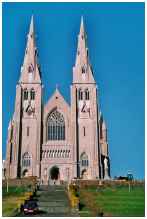
|
NEWRY
South of Armagh, towards the border but actually just in
County Down, is the much larger town of Newry. Newry is a
19th century church crawlers paradise - there are
hundreds of them (churches, not crawlers). The jewel in
the crown is the Catholic cathedral, a vast gothic hulk
not unlike St Andrew's in Dundalk, 9 miles away, although
not a copy of any English college chapel that I've ever
come across.
DERRY
The sites of Derry's two cathedrals tell you a lot about
the history of this pleasant little city. St Columb's,
the Anglican Cathedral, fits snugly inside the walls
defended by the protestant Apprentice Boys during the
siege of 1689, and the church contains much memorabilia
of that time, including the shell fired by James II's
army with a demand for surrender inside. "No
Surrender!" came the reply.
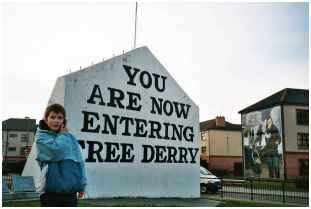
|
|
St Eugene's, the Catholic
cathedral, is set deep in the heart of the city's
Bogside, which starts just beyond the
appropriately named Butcher's Gate in the city
wall; it is actually barely half a mile from its
Anglican counterpart, although there was little
work done together between the two until
relatively recently.
Although St Eugene is a fine 19th century
building, and has undergone an excellent
post-Vatican II re-ordering, it is St Columb's
that wins in the interest stakes here. It is that
rare thing; apart from the 19th century addition
of a chancel, it is an almost entirely early 17th
century cathedral, the first to be built in the
British Isles after the Reformation.
Because of this, it feels very different to
anything in England. |
One detail of interest is that the
baptistery includes a memorial window to Mrs Cecil
Frances Alexander, writer of 'Once in Royal David's City'
and 'There is a Green Hill Far Away', both illustrated in
the glass. Also, the chapter house museum, which includes
relics of the siege that are treated with almost holy
veneration. Two people on welcoming duty inside were very
friendly, although a bit sniffy about their neighbours.
Eighty miles away, Belfast
has done its best to scour itself of evidence of
the Troubles. Derry positively celebrates them.
The gable ends in the Bogside are one of Europe's
biggest art projects; standing on the Derry walls
looking down, you can read the story of Free
Derry, the Civil Rights Movement, and the unhappy
events of the two decades after. Also on the
walls, beside the rather disturbing police
station, and just to the south of where the
Apprentice Boys march congregates every August,
is Europes only spoken word Arts Centre.
From all the news reports of the last thirty
years or so, you might think Derry a miserable
place, but nothing could be further from the
truth.
It is a smashing little town, smaller than you'd
think - it rather reminded me of Alnwick. Unlike
Alnwick, it has had more money pumped into it
over the last five years than probably any other
town in Europe, including the glitzy Foyleside
shopping centre, which must seem a fair exchange
for laying down the guns. |
|
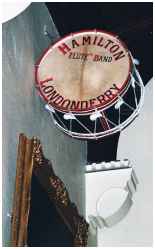
|
COUNTY
DERRY/COUNTY ANTRIM COAST
The coastal area where counties Derry and Antrim meet is
perhaps the most beautiful stretch of coastline anywhere
in the British Isles. It is also probably the most
thoroughly English area of the whole of Ireland, and I do
not exclude the outer southern suburbs of Dublin from
this.
Portrush, Portstewart and Castlerock are like something
out of Sussex or Dorset in the 1950s - with the addition
of dramatic cliffs thrown in. Not far off is the Giants
Causeway, and the Bushmills distillery. Coleraine, just
to the south, is like an old-fashioned English market
town, and appears rather overwhelmed by its campus
university and massive European-funded shopping centre.
If the ugly, fortified police stations seem out of place
anywhere in the North, it is here.
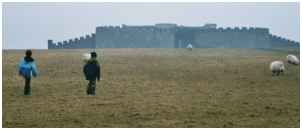
Above Castlerock you
can climb through the mist to Bishop Hervey's palace (now
in ruins) and the amazing cliff-top Mussenden temple,
actually the Bishop's library, looking like a prototype
of the Ickworth rotunda that he would build in Suffolk 20
years later. it stands some 300 feet above the sea
crashing on the rocks below. Apart from that, all there
is up there is sheep.
Coming down again, I found the smashing little high
Anglican Christ Church, a stunning little jewel inside of
darkness and gorgeous windows. Just perfect.
BELFAST
Belfast has always been one of my favourite cities. It
has a spirit that few English cities can match - perhaps
only Newcastle, which is a similar size. Despite
everything that has been thrown at it during the 20th
century, it still has a buzz about it, and is currently
thriving, for the same reason as Derry - the massive
amount of money that has been poured into it as one of
the conditions of the peace process. However, this has
had an unfortunate repercussion for churchcrawlers, as we
shall see.
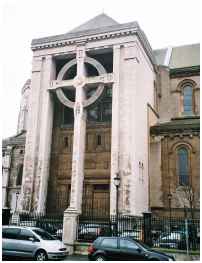
|
|
Pride of place in Belfast
must go to the gorgeous Church of Ireland
Cathedral, St Anne's. Almost entirely a product
of the 20th century (it was begun in 1899), it
enshrines the best of all the movements of the
century - Arts and Crafts, Art Deco, Modernism,
1930s triumphalism, all topped off with a
Festival of Britain sheen.
It is one of my favourite Anglican cathedrals.
The glass is particularly good, and I love the
peace chapel - everything is of the highest
quality, and on a much grander scale than the
Derry and Armagh Anglican cathedrals, which it
dwarfs.Most noteworthy of all, perhaps, is the
remarkable north transept.
The Catholic cathedral, St Peter's, is in the
Lower Falls Road, and is similar to, but smaller
than, the Catholic cathedral at Armagh. At one
time it was surrounded by mean terraced streets,
but these have all been swept away, as have the
monolithic Divis Flats that once overshadowed it.
In their place are pleasant cul-de-sacs and
courtyards, and pretty houses designed in that
curious gothic eavesy style of the 1990s. |
The road layout is
mainly to stop loyalist thugs driving through at high
speed firing machine guns at random Catholics, but it is
all very pleasant. The area at the front of the
cathedral, now called St Peter's Place, has been turned
into a sort of plaza flanked by what appear to be 19th
century almshouses, but are all 1990s built. Inside, it
is very 1890s, with wall mosaics and cast iron pillars.
Unless you are a
determined medievalist, Belfast is the ultimate
churchcrawlers paradise. It must have more
churches per head of population than any other
city on earth. There are hundreds and hundreds
and hundreds of the things - you can't walk 100
metres anywhere in the city without passing one.
You find Presbyterian churches of slightly
differing theologies side by side with each
other, Methodist churches of every hue, towering
Church of Ireland buildings facing towering
Catholic buildings, intriguing little churches
for Moravians, Anabaptists, Unitarians, Free Will
Gospellers, Apostolics, Reformed Apostolics, Free
Reformed Apostolic Anabaptist Gospellers - the
list goes on and on. Most of them are delightful
19th century gothic non-conformist buildings of
the highest quality. |
|
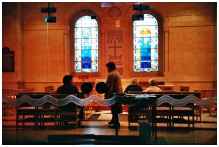
|
If you find this
enticing, and want to go and see them, then go now.
Belfast is undergoing urban regeneration on a scale
unseen in these islands since the 1960s. One of the
spin-offs of the peace process was that the big
multinational companies agreed to come in and build
shopping centres - the North was relatively free of
chainstores when the bullets were flying about. These
multinationals want to buy large brownfield sites near
the centre of Belfast. Presbyterians and Methodists are
relatively unsentimental about their buildings, and not
unreasonably are taking the money and running for the
suburbs, where they can build new churches in
considerable style. Great swathes of the outer town
centre are disappearing under some of the biggest
Sainsburys and Tescos you have ever seen. Many of the
churches will be demolished.
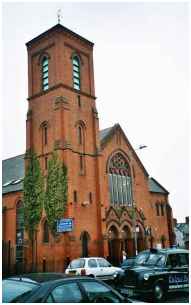
|
|
Depopulation is in any
case taking its toll. Sandy Row, for example, a
protestant area probably familiar to Van Morrison
fans, is being almost entirely redeveloped. One
of the grand Methodist churches has recently
closed, and will almost certainly be demolished.
The Catholic Short Strand has also undergone the
same experience of depopulation. The only central
areas where there is no over-development at
present are ones where the heritage lobby has a
powerful voice, and those where communities have
been unwilling to engage in the peace process.
Ironically, and for these two different reasons,
two places where a churchcrawler can still have
fun are the Catholic Falls and the Protestant
Shankill.
The Falls has really come up, and not just at the
lower end. There is a spirit of great confidence,
with lots of new businesses opening, but the area
is very conscious that it is a tourist draw,
especially for Americans. There are now Thai
restaurants and wine bars, and the houses towards
Milltown Cemetery are the same price as if they
would be if they were in Ipswich.
The old Presbyterian church, halfway up the
Falls, has been converted into an amazing
community facility, with a visitors centre, a
tourist information centre (you can book tickets
at any of the city centre theatres here), a
community restaurant, an internet cafe, an Irish
language bookshop (I was very tempted by the
Simpsons t-shirts in Gaelic) and a citizens
advice centre. |
I liked it all very
much indeed - it is the best church conversion I have
ever seen.
One church that probably won't survive the regeneration
is the delightful little corrugated iron chapel I came
across in Andersonstown, at the top of the Falls. It is
set in a wide churchyard that doesn't seem to have been
used for burials. Andersonstown ia one of the most
hardline republican areas of all - the IRA campaign for
most of the 1970s and 1980s was run from here, before
Gerry Adams changed the face of Republicanism for ever.
In fact, it is a pleasant area of large 19th century
redbrick houses, with a reasonable 1930s and 1960s
lowrise estate leading into Ballymurphy and New Lodge.
The little corrugated
church is not long for this world - I predict
yuppie flats coming soon. Other nationalist areas
aren't quite so gentrified - visit the Ardoyne if
you want a frisson of what the Falls used to be
like.
In complete contrast, the intransigent Shankill
is shabbier than ever. Every gable end enshrines
a mural threatening the Peace Process, the
British Government, Drumcree, Catholics, or the
world in general.
The pretty little Anglican church of St Anne at
the top of the Shankill has closed, and is
undergoing conversion into a community centre. It
was all boarded up and covered in scaffolding,
which was a shame, since I was looking forward to
going inside. The church was built in the 1890s
Arts and Crafts movement style, in the shape of a
shamrock, and with amazing mosaic windows. I hope
they make as good a job of it as the one on the
Falls. |
|
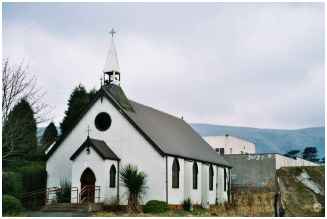
|
I walked down towards
the lower Shankill, past St Anne's sister church of St
Matthew, known as 'Matts' - the Peace Line loomed about
fifty metres beyond. I wandered on past one of Ian
Paisley's free Presbyterian churches. Outside, a man with
a microphone was haranguing the passers by about the day
of judgement. With the flags and slogans all around, and
the voice resonating from the walls, it was like a scene
out of Khomeini's Iran. Further down, the Shankill Gospel
Hall is built in that 1960s style beloved of seaside
cinema architects. This was Johnny Adair country - now it
is a land of lawless gangsters, shooting it out among the
terraces after dark. The UDA have been reluctant so far
to participate in the peace, and consequently businesses
have been reluctant to participate in the Shankill. All
around are boarded up shops and scary pubs.
Not far from the Gospel Hall, and near to the fish and
chip shop blown up by the IRA in 1994 (ten people died,
and the outcry did more than anything at the time to
precipitate the Peace Process) I looked inside a
self-styled Shankill Souvenir Shop. A bit of a contrast
to the community bookshop on the Falls. Hardly any books
at all here, just photocopied pamphlets with grim titles.
Flags and t-shirts covered the walls. Amongst the Union
Jacks and Red Hands of Ulster, there were Serbian flags
and, bizarrely, Israeli flags. A T-shirt said "There
are no Catholic areas of Northern Ireland. There are only
ghettos waiting to be cleansed". Now, who would ever
wear THAT, and where? Up the pub? At home watching the
television? Blimey. I made my excuses, and left.
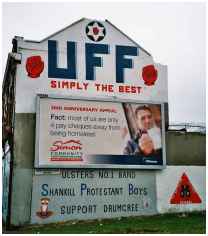
|
|
